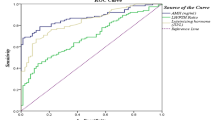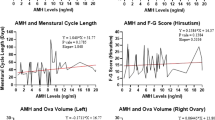Summary
The present study aimed to investigate the clinical value of serum anti-mullerian hormone (AMH) and inhibin B (INHB) in predicting the ovarian response of patients with polycystic ovary syndrome (PCOS). A total of 120 PCOS patients were enrolled and divided into three groups in terms of the ovarian response: a low-response group (n=36), a normal-response group (n=44), and a high-response group (n=40). The serum AMH and INHB levels were measured by enzyme-linked immunosorbent assay (ELISA). The follicle stimulating hormone (FSH), luteinizing hormone (LH), and estradiol (E2) levels were determined by chemiluminescence microparticle immunoassay. The correlation of the serum AMH and INHB levels with other indicators was analyzed. A receiver operating characteristic (ROC) curve was established to analyze the prediction of ovarian response by AMH and INHB. The results showed that there were significant differences in age, body mass index (BMI), FSH, total gonadotropin-releasing hormone (GnRH), LH, E2, and antral follicle counts (AFCs) between the groups (P<0.05). The serum AMH and INHB levels were increased significantly with the ovarian response of PCOS patients increasing (P<0.05). The serum AMH and INHB levels were negatively correlated with the age, BMI, FSH level, Gn, and E2 levels (P<0.05). They were positively correlated with the LH levels and AFCs (P<0.05). ROC curve analysis of serum AMH and INHB in prediction of a low ovarian response showed that the area under the ROC curve (AUC) value of the serum AMH level was 0.817, with a cut-off value of 1.29 ng/mL. The sensitivity and specificity were 71.2% and 79.6%, respectively. The AUC value of serum INHB was 0.674, with a cut-off value of 38.65 ng/mL, and the sensitivity and specificity were 50.7% and 74.5%, respectively. ROC curve analysis showed when the serum AMH and INHB levels were used to predict a high ovarian response, the AUC value of the serum AMH level was 0.742, with a cut-off value of 2.84 ng/mL, and the sensitivity and specificity were 72.7% and 65.9%, respectively; the AUC value of the serum INHB level was 0.551 with a cut-off of 45.76 ng/mL, and the sensitivity and specificity were 76.3% and 40.2%, respectively. It was suggested the serum AMH and INHB levels have high clinical value in predicting the ovarian response of PCOS patients.
Similar content being viewed by others
References
Carmina E, Azziz R. Diagnosis, phenotype, and prevalence of polycystic ovary syndrome. Fertil Steril, 2006,86(Supp 1):S7–S8
Itman C, Mendis S, Barakat B, et al. All in the family: TGF-beta family action in testis development. Reproduction, 2006,132(2): 233–246
Visser JA, de Jong FH, Laven JS, et al. Anti-mullerian hormone: a new marker for ovarian function. Reproduction, 2006,131(1): 1–9
Hansen KR, Hodnett GM, Knowlton N, et al. Correlation of ovarian reserve tests with histologically determined primordial follicle number. Fertil Steril, 2011, 95(1): 170–175
Balasch J, Creus M, Fabregues F, et al. Inhibin, follicle-stimulating hormone, and age as predictors of ovarian response in vitro fertilization cycles stimulated with gonadotropin-releasing hormone agonist-gonadotropin treatment. Am J Obstet Gynecol, 1996,175(5): 1226–1230
Ficicioglu C, Kutlu T, Demirbasoglu S, et al. The role of inhibin B as a basal determinant of ovarian reserve. Gynecol Endocrinol, 2003,17(4): 287–293
Seifer DB, Lambert Messerlian G, Hogan JW, et al. Day 3 serum inhibin-B is predictive of assisted reproductive technologies outcome. Fertil Steril, 1997,67(1): 110–114
Pellatt L, Hanna L, Bfineat M, et al. Granulosa cell production of anti-mullerian hormone is increased in polycystic ovaries. J Clin Endocrinol Metab, 2007,92(2): 240–245
Broer SL, Dolleman M, Opmeer BC, et al. AMH and AFC as predictors of excessive response in controlled ovarian hyperstimulation: a meta-analysis. Hum Reprod Update, 2011,17(1): 46–54
Sarah W, Maya L, Evgenia G, et al. AMH levels in adolescents with polycystic ovary syndrome (PCOS). J Pediatr Adolesc Gynecol, 2015,28(2):e44–e45
Christos V, Neoklis AG, Anastasia KA, et al. Sibutramine administration decreases serum anti-Mullerian hormone (AMH) levels in women with polycystic ovary syndrome. Eur J Obstet Gynecol Reprod Biol, 2012,163(2): 185–189
Weenen C, Laven JS, Von Bergh AR, et al. Anti-mullerian hormone expression pattern in the human ovary: potential implications for initial and cyclic follicle recruitment. Mol Hum Reprod, 2014,20(2): 77–83
Durlinger AL, Gruijters MJ, Kramer P, et al. Anti-mullerian hormone inhibits initiation of primordial follicle growth in the mouse ovary. Endocrinology, 2002, 143(3): 1076–1084
La Marca A, Sighinolfi G, Radi D, et al. Anti-mullerian hormone (AMH) as a predictive marker in assisted reproductive technology (ART). Human Reprod Update, 2010,16(2): 113–130
Hazout A, Bouchard P, Seifer DB, et al. Serum anti-mullerian hormone/mullerian-inhibiting substance appears to be a more discriminatory marker of assisted reproductive technology outcome than follicle-stimulating hormone, inhibin B, or estradiol. Fertil Steril, 2004,82(5): 1323–1329
Lambalk CB, Van Disseldorp J, de Koning CH, et al. Testing ovarian reserve to predict age at menopause. Maturitas, 2009,63(4): 280–291
Visser JA, Themmen AP. Anti-mullerian hormone and folliculogenesis. Mol Cell Endocrinol, 2005,234(1-2): 81–86
Clark CA, Laskin CA, Cadesky K. Anti-mullerian hormone: reality check. Human Reprod, 2014,29(1): 184–185
Broer SL, van Disseldorp J, Broeze KA, et al. Added value of ovarian reserve testing on patient characteristics in the prediction of ovarian response and ongoing pregnancy: an individual patient data appmach. Hum Reprod Update, 2013,19(1): 26–36
Shayya RF, Rosencrantz MA, Chuan SS, et al. Decreased inhibin B responses following recombinant human chorionic gonadotropin administration in normal women and women with polycystic ovary syndrome. Fertil Steril, 2014,101(1): 275–279
Fawzy M, Lambert A, Harrison RF, et al. Day 5 inhibin B levels in a treatment cycles are predictive of IVF outcome. Hum Reprod, 2002,17(1): 1535–1543
Luisi S, Florio P, Reis FM, et al. Inhibins in female and male reproductive physiology: role in gametogenesis, conception, implantation and early pregnancy. Hum Reprod Update, 2005,11(3): 123–135
Hazout A. Quality of ovarian reserve: inhibin B on day 3 of the cycle or antimullerian hormone (AMH). Gynecol Obstet Fertil, 2006,34(2): 1001–1002
Author information
Authors and Affiliations
Corresponding author
Rights and permissions
About this article
Cite this article
Zhang, F., Liu, Xl., Rong, N. et al. Clinical value of serum anti-mullerian hormone and inhibin B in prediction of ovarian response in patients with polycystic ovary syndrome. J. Huazhong Univ. Sci. Technol. [Med. Sci.] 37, 70–73 (2017). https://doi.org/10.1007/s11596-017-1696-x
Received:
Revised:
Published:
Issue Date:
DOI: https://doi.org/10.1007/s11596-017-1696-x




